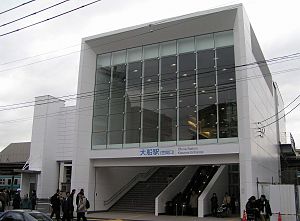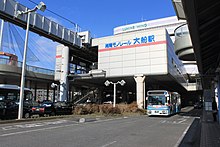Ōfuna station
| Ōfuna ( 大船 ) | |
|---|---|
|
Entrance to the northern riding station (2006)
|
|
| Data | |
| Design | Crossing station |
| Platform tracks | 10 (railway) 1 (monorail) |
| abbreviation | JT07 / JK01 / JO09 / JS09 |
| opening | November 1, 1888 |
| location | |
| City / municipality | Kamakura |
| prefecture | Kanagawa |
| Country | Japan |
| Coordinates | 35 ° 21 '15 " N , 139 ° 31' 53" E |
| Height ( SO ) | 10 m TP |
| Railway lines | |
|
Shōnan Monorail Decommissioned: |
|
| List of train stations in Japan | |
The station Ōfuna ( Japanese 大船 駅 , Ōfuna-eki ) is a train station on the Japanese island of Honshū . The major transport hub is located in Kanagawa Prefecture in the area of the city of Kamakura and is operated jointly by the railway companies JR East and Shōnan Monorail .
links
Ōfuna is a crossing station on the Tōkaidō main line from Tokyo via Nagoya to Osaka , one of the most important railway lines in Japan. It crosses with or runs partially parallel to the Yokosuka Line from Tokyo via Yokohama to Kurihama . Likewise, Ōfuna is the terminus of both the Shōnan-Shinjuku line and the Negishi line . The former leads via Yokohama and Shinjuku to Ōmiya , where it is linked to the Utsunomiya line and the Takasaki line . The latter leads via Shin-Sugita to Yokohama and forms the continuation of the Keihin-Tōhoku line . All of these lines are operated by the JR East railway company. In addition, there is the Shōnan Monorail of the railway company of the same name, a monorail to Enoshima .
On the Tōkaidō main line, eight to twelve trains run every hour in the direction of Odawara, and six or seven trains in the direction of Tokyo ( up to 17 trains per hour during the morning rush hour). These are mainly the express trains Rapid Acty ( 快速 ア ク テ ィ ー , Kaisoku akutī ), Commuter Rapid ( 通勤 快速 , Tsūkin Kaisoku ) and Shōnan Liner ( 湘南 ラ イ ナ ー , Shōnan Rainā ). On the Shōnan-Shinjuku line four to seven local and express trains are offered per hour, on the Yokosuka line five to ten. The Negishi line is used by six to twelve local trains every hour, with some being transferred to and from the Yokohama line during rush hour .
Ōfuna is an important hub for regional and local bus transport, with 17 stops at three different bus terminals . These are located at the exit of the northern equestrian station opposite the Oh! Plaza, next to the monorail station and in front of the western exit of the southern equestrian station. They are served by 60 bus routes operated by Enoden Bus , Kanagawa Chūō Kōtsū , Keihin Kyūkō Bus , Nankai Bus and Shōnan Keikyū Bus .
investment
Half of the station is in Kamakura and half in Yokohama , with the Sunaoshi stream, which is bridged roughly in the middle of the area, forming the city limits. The northern half belongs to the Kasama district in Yokohama's Sakae-ku district , the southern half to the eponymous district Ōfuna. Since the station board's office has always been in the Kamakura area, the station is assigned to this city. About two hundred meters west of the train station, on the opposite side of the Kashio River, stands the Ōfuna-Kannon on a hill .
The north-south facing system of the JR East railway company consists of 13 tracks, ten of which are used for passenger traffic. These are located on five covered central platforms and are connected to each other near both ends by a riding station . While the southern one spans the entire complex, only the eastern side can be reached from the northern one. Above the roofs of the second and third platforms - seen from the east - the Atre Ofuna shopping arcade with two dozen shops extends along the longitudinal axis between the two riding stations .
Three more tracks run on the west side of the facility. While the westernmost serves as a siding, the other two belong to the Tökaidō freight line . This route, reserved exclusively for rail freight traffic, belongs to the railway company JR Freight and serves to bypass the Yokohama agglomeration over a wide area. The southern equestrian station is connected on its east side to the six- story Lumine Wing shopping center , which is owned by a subsidiary of JR East. The elevated terminus of the Shōnan Monorail can be reached from both buildings . Your lane is surrounded by two side platforms so that you can get on and off separately. All buildings of the station are barrier-free .
In the 2018 fiscal year, an average of 128,382 passengers used the station every day. Of these, 99,944 were accounted for by JR East and 28,438 by the Shōnan Monorail.
Tracks
- railroad
| 1/2 | ▉ Main Tōkaidō line | Yokohama • Tokyo • Ueno |
| ▉ Shōnan-Shinjuku line | Yokohama • Shibuya • Shinjuku | |
| 3/4 | ▉ Main Tōkaidō line | Fujisawa • Odawara • Atami |
| 5/6 | ▉ Yokosuka line | Yokohama • Tokyo • Chiba • Narita Airport |
| ▉ Shōnan-Shinjuku line | Yokohama • Shibuya • Shinjuku • Ōmiya | |
| 7/8 | ▉ Yokosuka line | Kamakura • Kurihama |
| 9/10 | ▉ Negishi line | Negishi • Yokohama • Tokyo • Ueno • Ōmiya |
| ▉ Yokohama Line | Yokohama • Machida • Hachiōji |
- Monorail
| 1/2 | ▉ Shōnan Monorail | Shonan Enoshima |
photos
history
During the construction of the Yokohama - Kōzu section of the Tōkaidō main line , the state railway administration had already planned a separation station for the branch line to the Miura Peninsula, which was also to be built . However, there were disagreements about the exact location, which is why the trains ran here without stopping for over a year. The Ōfuna station was opened on November 1, 1888, and that of the Yokosuka line branching off here via Kamakura to Yokosuka seven and a half months later on June 16, 1889. Cargo handling began on May 25, 1894. Due to the strong growth in traffic, the station had to be significantly expanded after only three decades; the corresponding work was completed in May 1917. The Great Kanto earthquake caused severe damage on September 1, 1923. All buildings with the exception of the fuel depot collapsed or were no longer usable. Nine days later, the water supply also failed, so that the water had to be pumped out of the Sunaoshi stream for six weeks to operate the steam locomotives. The reconstruction of the station lasted until August 1925.
On November 25, 1950, the Japanese State Railways opened a siding to the Ōfuna PX tank farm north of the station, which had been requisitioned by the United States Army five years earlier . During the Korean War , the state railway carried up to a hundred tank cars a day , but in 1958 it was only two per day, so that the facility was finally shut down in stages from 1965 to 1967 and the area that had become vacant was then built over. The company Dream Development adopted on 2 May 1966, the Yokohama Dreamland Monorail in operation, a 5.3 km long monorail from the station Ofuna to the theme park Yokohama Dreamland . Due to serious construction defects, it was only in operation until September 24, 1967 and then disintegrated; their official shutdown took place only in 2002. The experience gained in this failure flowed into the construction of the Shōnan Monorail from Ōfuna to Enoshima , which began operations on March 7, 1970. In the meantime, the state railway had started to replace the station building with a riding station and opened it on April 1, 1971.
In August 1972 the state railway stopped handling goods, but continued to operate the sidings to the Sumitomo Electric and Sumitomo Osaka Cement plants until 1984. On April 9, 1973, she extended the Negishi line , which had previously ended in Yōkōdai, to this point, completing the railway junction and making Yokohama accessible on a second route. To save money, she stopped checking in on November 1, 1984. As part of the privatization of the state railway, the station passed into the possession of the new company JR East on April 1, 1987 . In February 2006, the Dila Ōfuna (now Atre Einkaufszentrumfuna) shopping center opened its doors.
Adjacent train stations
|
←
|
Lines |
→
|
||
|---|---|---|---|---|
| Totsuka |
JR East |
Fujisawa | ||
| Totsuka |
|
Fujisawa | ||
| Hongōdai |
|
The End | ||
| Totsuka |
JR East |
Kita Kamakura | ||
| Beginning |
|
Fujimicho | ||
| Beginning |
(1966-1967) |
Dreamland | ||
Web links
- JR East Station Information (Japanese)
- Station information from Shōnan Monorail (Japanese)
Individual evidence
- ↑ JR 時刻表 2019 年 3 月 号 (JR timetable March 2019). Kōtsū shinbunsha, Tokyo 2019.
- ↑ 各 駅 の 乗車 人員. JR East , 2018, accessed April 26, 2020 (Japanese).
- ↑ 鎌倉 の 統計. Kamakura City, June 24, 2019, accessed April 26, 2020 (Japanese).
- ↑ Yasumitsu Kanie: 横須賀 線 を 訪 ね る 120 年 歴 史 の 旅 . Kōtsū shinbunsha, Tokyo 2010, ISBN 978-4-330-11810-9 , pp. 120 .
- ↑ a b c d 大船 駅 七 十年 . Japanese State Railways , Tokyo 1958 (NCID BB19184555).
- ↑ 関 東 大 震災 と 鉄 道 . Shinchōsha, Shinjuku 2012, ISBN 978-4-10-332561-1 , pp. 102 .
- ↑ Daiei unit gives up rights to Kanagawa monorail. The Japan Times , August 22, 2002, accessed April 26, 2020 .
- ↑ Tetsu Ishino (Ed.): 停車場 変 遷 大事 典 国 鉄 ・ JR 編 1 . JTB, Tokyo 1998, ISBN 4-533-02980-9 (station change directory JNR / JR).







